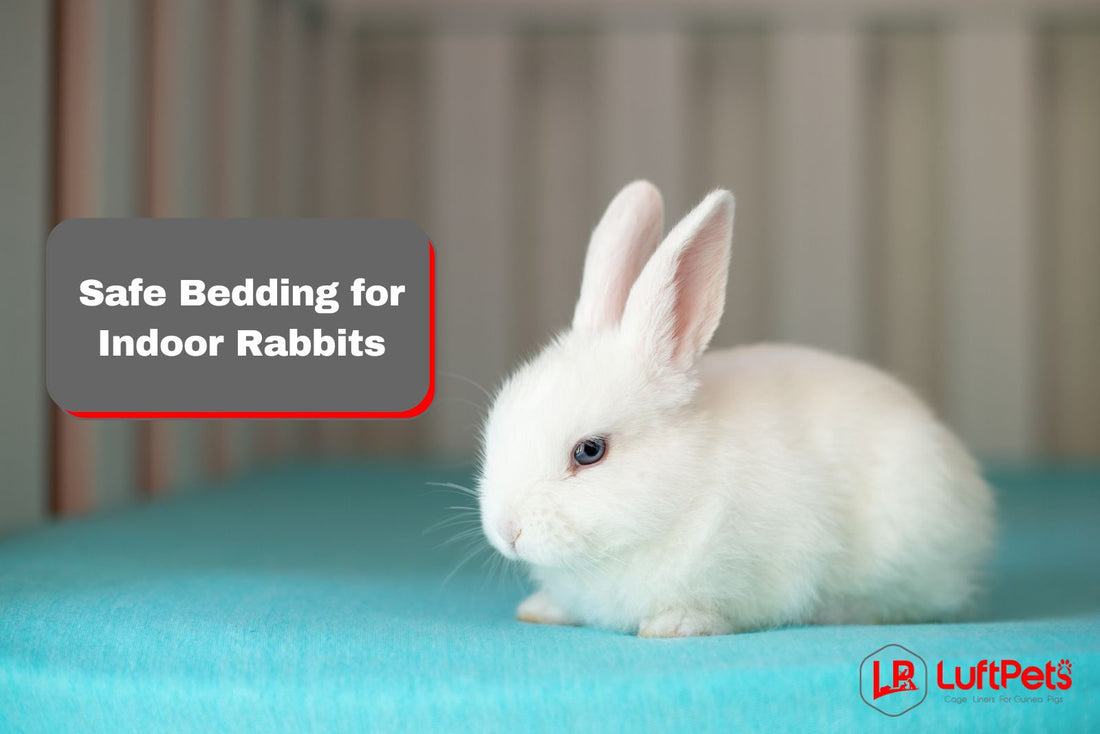Are you wondering which is the best bedding for indoor rabbits?
When I got my first pet rabbit, I thought the only safe option was straw and was overwhelmed by all the available bedding types at the pet store.
Over the years, I've tried several types of bedding for rabbits, and I'm here to share their pros and cons with you so you can choose the best one for you.
Just keep reading.
Key Takeaways
- Indoor rabbits don't need bedding in their cage to keep them warm and comfortable, but they should have suitable litter bedding available.
- Paper, cage liners, and fleece are among the most suitable bedding options for indoor rabbits.
- Avoid using pine pellets, cedar shavings, or cat litter in the rabbit's habitat.
Do You Need to Put Bedding in the Rabbit Cage?
As a novice rabbit owner, I thought you had to line the cage with straw bedding. However, friends of mine mentioned that indoor rabbits can do without bedding at all.
So, before discussing suitable types of bedding for indoor rabbits, let's see whether you need to provide bedding material for your bunny.
Wild rabbits line their burrows with warm natural materials to protect themselves from the elements and build a nest to give birth.
However, indoor rabbits are not exposed to cold temperatures and aren't at risk of freezing, so bedding in the cage is optional.
Some experts advocate against bedding because it can interfere with litter training. If your pet sees the whole cage as a toilet, keeping the rabbit hutch clean will be hard!
Moreover, soiled bedding can attract bugs and insects, which puts your pet bunny at risk of diseases. It can also stink up the whole house. Afterall, when considering what bunnies need in their cage, a key factor is providing a clean, stimulating environment.
Watch this video for more information.
But if you do opt for bedding, ensure it's safe and suitable for rabbits. For instance, are pine pellets safe for rabbits? It's essential to research and choose bedding materials that won't harm your furry friend.
Still, you need to provide suitable bedding for the litter box. And some bunnies like to have cozy bedding to burrow or protect their feet.
7 Safe Bedding Options for Indoor Rabbits
So, what is the best bedding for indoor rabbits?
If you plan on using bedding in the cage, you should look for a soft material with excellent absorbency properties and odor control.
But let me give you a piece of advice. Pick one type of material for your rabbit litter tray and a different one for bedding.
Otherwise, your bunny will get confused and do its business all over the cage. If you're wondering about the specifics of this, the topic "do rabbits need bedding and litter" provides further insights.
Here are my top suggestions with their pros and cons. Or just look at the table below.
| Pros | Cons | |
| Paper Bedding |
Absorbent material Dust-free Soft Good odor control |
A bit messy to clean |
| Fabric Bedding |
Soft Cozy Absorbent Dust-free Mess-free |
Requires frequent washing High initial cost Not for chewers |
| Grass mat |
Easy to clean Comfortable Dust-free Natural materials |
Not the most absorbent bedding You have to replace it |
| Aspen Bedding |
Great odor control Absorbent material Soft and comfortable Safe to ingest |
Messy to clean A bit dusty
|
| Fabric Beds |
Cozy Dust-free Easy to wash Great for hiding |
Not for chewers Some rabbits don't like beds Not the best odor control |
| Cage Liners |
Absorbent Cozy Dust-Free Waterproof |
Not the best option for chewers Need frequent washing High initial cost |
| Straw |
Absorbent Warm Dust-free |
Need frequent changing Messy |
#1 Paper-Based Bedding
Paper is an excellent absorbent material, so it is the perfect bedding if your bunny has accidents outside the litter box. It's also soft, comfortable, and great for burrowing.
However, it's important to know how often to change rabbit bedding to maintain a clean and hygienic environment for your pet.
More importantly, paper-based bedding is relatively dust-free, so it will not irritate your bunny's respiratory system and cause breathing problems.
High-quality commercial paper-based beddings have unique formulas to neutralize unpleasant smells, so you don't have to worry about ammonia odors in the house.
Experts from PetMD also explain, "Paper is digestible and will not obstruct a rabbit's gastrointestinal tract if ingested." And I like paper-based bedding because it's relatively cheap, recyclable, and eco-friendly. (1)
Paper pellets are also a great option for your rabbit's litter box because of their absorbency, but they can also work as bedding if you cover them with straw or another soft material.
However, paper is a bit messy to clean, especially if you use shredded paper, since bunnies can kick it out of the enclosure.
#2 Fabric Bedding
Fleece and cotton towels are popular choices among pet owners for good reasons. They are soft, cozy, absorbent, dust-free, and mess-free. And they encourage natural behaviors, such as burrowing.

I also love using fleece and cotton because I can machine wash them whenever they get dirty, and there are no fleece particles all over the house.
Moreover, according to studies, cotton is one of the best choices for rabbits with sensitive feet at risk of bumblefoot. And while the initial cost of fabric bedding is high, it's cheaper in the long run. (2)
However, if your bunny is a chewer, I would be careful with fleece blankets or towel bedding. Eating fabric can lead to intestinal obstruction.
Moreover, if you use fleece/cotton, you must wash frequently to prevent unpleasant smells. Like guinea pigs, rabbits spray urine to mark their territory so their bedding can get quite smelly.
#3 Grass Mats
A grass mat is made from natural materials, such as grass, hay, or stray. It provides comfort, insulation, and entertainment. That's why it's an excellent bedding choice for rabbits.
Grass is also safe for rabbits to ingest, so you don't have to worry whenever your bunny takes a bite out of its bedding. And it's an excellent chew toy for rabbits to wear down their teeth.
You can find grass mats in a wide range of sizes, so it's easy to find the perfect size for your bunny's enclosure.
Unfortunately, grass isn't the most absorbent material and doesn't have excellent odor control. And you'll have to replace it when your rabbit is done chewing it.
#4 Aspen Bedding
Some types of wood shavings are an excellent option for rabbit bedding. I recommend aspen shavings because they're non-toxic, comfortable, and absorbent.
Aspen bedding is also environmentally friendly, provides adequate odor control, and won't cause problems if ingested. It also lasts longer than paper-based bedding and needs less changing.
Wood pellets are also an excellent choice for indoor bunnies because they are cheap, absorbent, and easy to maintain. And they're a relatively dust-free bedding, soft on your bunny's paws.
However, aspen or wood pellets can be messy indoor bedding, especially if your rabbits like to dig. And it's not the best choice for rabbits with respiratory problems because it's a bit dusty.
#5 Fabric Beds
If you're looking for comfortable bedding for your bunny to sleep in, I recommend getting a cat bed. A basket with blankets or towels is also an excellent option.
The main disadvantage of fabric beds is that rabbits can chew them and ingest the material. Also, the beds get dirty and smelly quickly, so you need to wash them often.
Fabrics also don't have the same odor control as paper or wood shavings. But it's perfect for bunnies with sensitive feet or respiratory problems.
#6 Cage Liners
I love cage liners because they're easy to use, absorb urine well, and don't get stuck to the bottom of the cage. They're also cost-efficient, soft, and dust-free.
My recommendation is Luftpets's small animal cage liners. I like them because they're made from waterproof material and don't slip around the cage.
However, liners are the best option for chewers. Even though liners aren't made from toxic materials, eating more than a few pieces can lead to health problems.
Moreover, you'll have to buy at least two cage liners. You must have a spare one to put in the habitat while washing the dirty bedding.
#7 Straw Bedding
Straw is an excellent bedding option because it has superb insulation properties, keeping your rabbit warm during the cold season.
However, I recommend straw for outdoor rabbit cages. It's a nightmare to clean straw around the cage, and rabbits tend to kick it out of the enclosure.

Moreover, you must put clean bedding in the cage every few days to prevent bug infestation and other health problems.
Still, straw can be a cheap alternative to more expensive types of bedding, as long as you don't mind the mess or worry about your bunny eating its substrate.
And now, let's talk about what bedding you should avoid in the rabbit hutch or the litter tray.
What Bedding to Avoid in the Cage and Litter Box?
Rabbits chew all the time to wear down their teeth, so you should avoid bedding materials that are toxic or dangerous for rabbis to ingest, such as:
- Cat Litter. Clay litter is not suitable for rabbits because it clumps when wet and can cause an intestinal obstruction. But paper pellet cat litter is safe.
- Pine shavings. Pine contains phenols that damage the rabbit's liver, according to specialists. But it can be a comfortable bedding material if it's kiln-dried to remove the dangerous phenols. (3)
- Cedar shavings. Like pine, cedar has toxic phenols that can harm your rabbit's health if ingested or inhaled.
- Newspapers. The ink in newspapers can be a problem for rabbits if ingested. It's better to stick to plain paper.
- Sawdust. It's far too dusty for rabbits and can be messy to clean from the cage.
- Cardboard. Many rabbits love eating cardboard because it makes a perfect chew toy. But some cardboard is full of chemicals, which can upset your bunny's stomach.
FAQs
1. What should indoor rabbits sleep in?
Rabbits need a dark, quiet area in the cage to sleep in, where they feel protected from predators. It can be a box with straw bedding, a basket with blankets, or a cat bed.
2. Do indoor rabbits need straw bedding?
Indoor rabbits don't need straw bedding because they're not at risk of freezing during the night. But outdoor rabbits should have plenty of straw in the cage.
3. What fabric is safe for rabbits?
Cotton and polar fleece are safe fabrics for rabbits and shouldn't cause a digestive blockage if rabbits eat them in small amounts.
Conclusion
Indoor rabbits don't need traditional bedding in their hutch, but you can use paper, cage liners, or aspen shavings to line the bottom of the cage to maintain better hygiene.
And don't worry too much about your rabbit's comfort. Some bunnies don't mind sleeping on the bare floors as long as they have a cozy box with blankets or straw to hide from predators.
What do you think about these 7 bedding options for indoor rabbits? Which bedding do you use for your indoor bunny? Share your thoughts in the comment section.
Resources:
1. Bunnies Care Sheet [Internet]. www.petmd.com. [cited 2023 Sep 13]. Available from: https://www.petmd.com/rabbit/bunnies-care-sheet
2. Wolf P, Speers R, Cappai MG. Influence of different types of bedding material on the prevalence of pododermatitis in rabbits. Research in Veterinary Science. 2020;129:1–5.
3. Team HRS. The Dangers of Softwood Shavings [Internet]. House Rabbit Society. 2022 [cited 2023 Sep 13]. Available from: https://rabbit.org/2011/07/the-dangers-of-softwood-shavings/





